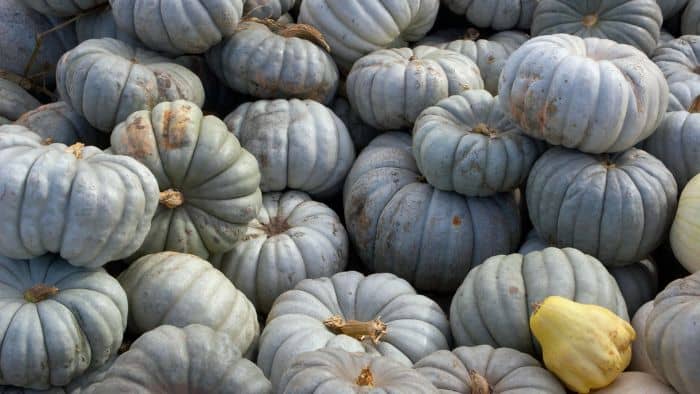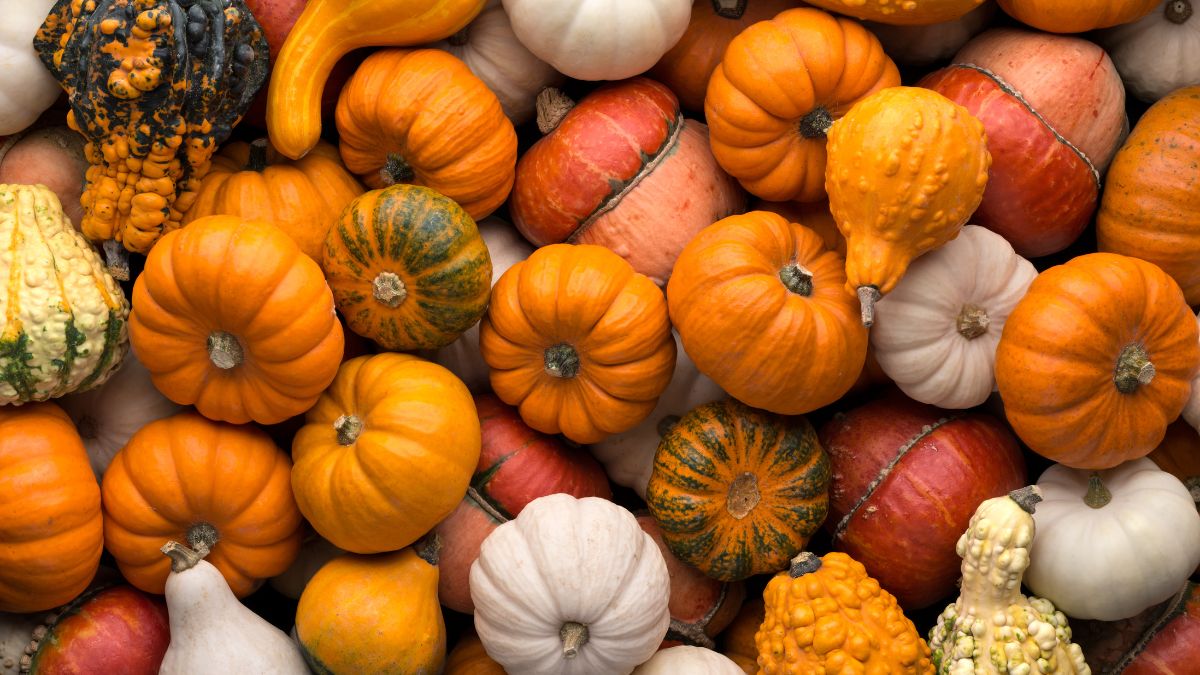What is the best soil for pumpkins? I grow pumpkins for a combination of yield and taste. You can grow very big pumpkins that look impressive, or you can grow small and medium pumpkins that taste great. This article is based on my twenty years of experience growing my own pumpkins, which I select for taste and yield. This is not information you will find anywhere else on the internet, so brace yourself for an interesting, different, and experienced read.
Why Do We Grow Pumpkins?
Pumpkins are an excellent, high-yielding food plant. The pumpkin flesh is rich in vitamins, and fiber and low in calories – it is an ideal food for anybody who wants to remain healthy, and fit and maintain a healthy body mass index.
Pumpkins have the ability to be stored for over a year, and mature with age much like a fine wine. This means that you can aim to grow a crop of “useful size” pumpkins, and you can store them. In this regard, having a large number of pumpkins that weigh in at 10-30lb per pumpkin is way better than producing one big half-a-ton or more pumpkins. The reason for this is that big pumpkins are difficult to process and tend to taste quite bad. If you have four large 100lb pumpkins, and three of them rot in the season while you store them, you end up with a very small amount of food to eat. Let me quickly elaborate on how to breed the best pumpkin seeds.

How To Select The Best Pumpkin Seeds For Your Land
I always suggest starting with a mix of heirloom pumpkin seeds. Good starter genetics are Queensland blue, Turkish Turban Pumpkins, New England Pumpkin Pie seeds, and Jade Prince seeds. The idea is to select quite a range of pumpkins because they will all get cross-pollinated mixing the genetics up.
In each area, there are different pests that limit production. So if you start with a big genetic sample of different seed types, and then let them all grow together, the seeds will cross-pollinate. You keep your pumpkins and slowly eat them as the year goes by. Eat a pumpkin that starts to look like it may be rotting. Cut the rotten bit out, and feed the seeds to your chickens. Eat the rest of the flesh.
You keep doing this until you have one or two pumpkins that last for a year. Keep the seeds from the longest-lasting pumpkins and you are ready to plant for the next season. In this way, you find the pumpkins that are least likely to get stung by pests and have the best disease and fungal resistance.
I have been doing this for twenty years and now have completely locally adapted seeds that are resistant to cucurbit fly and powdery mildew and thrive in my garden!!
Now that we have the seeds sorted out, let’s work out the best soil for pumpkins.
The Best Soil For Pumpkins
Pumpkins should in my opinion be planted in a mound. I make soil that is rich in manure and loam and make a huge mound at least two feet high and 6 feet in diameter. Then in the middle of this mound, you build a circular reservoir with a wall of soil around it. In the center of this, you plant 3 pumpkin seeds – 1 of each variety. Repeat with more mounds that are about 10 to 15 feet apart.
When you start the plants, you can flood-irrigate the mounds, and this simulates the natural spring rain soaking effect that germinates wild pumpkins and squash. If you are in a colder area start the pumpkins indoors in pots and plant them into the mound after the last frost.
The pumpkins will grow rapidly, absorbing water and growing nearly so fast you can see it happening. As they grow, they touch the soil around the mounds. This is where you can be clever – cover the soil around your pumpkins in a layer of compost, manure, and mulch. When the pumpkin vines touch this soil they will root.
You will need to irrigate both the center of the mound and the rest of the soil that the pumpkins occupy, ensuring that they receive adequate water. Pumpkins can drink water at an alarming rate.
How To Grow Bigger Pumpkins/How To Grow Big Pumpkins
When formulating the best soil for pumpkins it is important to understand a pumpkin’s feed requirements. Pumpkins are heavy feeders. If you read manuals they will tell you that pumpkins need this and that fertilizer, and so on. Healthy soil will provide the right nutrients to pumpkins. It is important that your soil has abundant compost, weathered manure, and bone meal in it. Wood ash can be applied from time to time in the central hole, as well as sprinkled on the soil to provide potassium. I normally put additional fresh manure in the central hole about a month into the growth.

If your soil is healthy, and you have abundant nutrients, pumpkins will grow fast. You can reduce the number of pumpkins per plant, by cutting off smaller pumpkins and just leaving a few pumpkins per vine. Baby squash fruits are delicious when cooked as a vegetable.
This can allow you to grow pumpkins that are in the 20-30 pound range. Anything above this is just about ego and serves no logical point as you cannot eat a 50-pound pumpkin without having a family of twenty, which is rare these days.
How Do You Grow A Giant Pumpkin?
To grow a giant pumpkin, you need to start with the right seeds such as Atlantic Giant. This is an exercise in excess as the fruit is nearly indelible and it is just a competition to grow a big pumpkin. If you wish to go down this path, prepare your soil as per the above instructions, and plant one pumpkin in the mound. Allow a lot of space for this pumpkin to ramble and after a few fruit sets, select the biggest one, and remove all other fruit so the pumpkin concentrates all of its energy in one fruit. This pumpkin will get very big if you provide enough water and nutrients.
Big Max Pumpkin Growing Tips
This is a funny cultivar. Big Max is not a terrible-tasting big pumpkin and can produce pumpkins that are up to 100 pounds in size. They are quite attractive looking with their orange skin and bulbous shape. Not a bad pumpkin if you wish to go down this path.
Again, I personally caution against growing really big pumpkins – they are a pain in the back to carry and serve very little nutritional function unless you donate them to a homeless shelter or similar that can use vast quantities of vegetables in one go. In this case, go wild – you are doing a good thing. For myself, I donate seeds to people who are short of food so that they can grow their own food. This works better in the long term.
In Conclusion – The Best Soil For Pumpkins
The best soil for pumpkins is rich in compost and manure and has the ability to hold water so that the pumpkins can absorb this water and pump it into their pumpkin fruits. Wood ash is always an excellent thing to sprinkle around the plants as they grow as it provides potassium.
The best soil for pumpkins is relatively easy to build – selecting the best pumpkin genetics for your area and soil takes time. With time, you will be able to produce huge crops of organic, tasty pumpkins. These will be diverse and unique just like you!!







